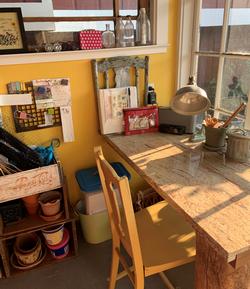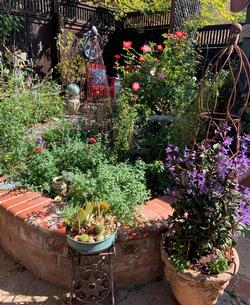Dig in to your garden info
-
Dot Zanotti Ingels
-
Generally, I would tell you I am an organized and efficient person. With my gardening, however, I often fly by the seat of my pants. My Master Gardener training and many years of experience certainly help me focus on the importance of my soil, my microclimates and planting the right plant in the right place. It did not, however, help me keep track of my hits and misses so I do or don’t repeat them.
 Welcome to my puttering shed. There is my garden journal front and center with everything I need to keep me organized while smiling.
Welcome to my puttering shed. There is my garden journal front and center with everything I need to keep me organized while smiling.When someone mentions the basic garden tools we should have, we immediately think of things like trowels, shovels and good gloves. I have learned that a garden journal needs to also be in my arsenal. Keeping a garden journal will help improve your gardening skills, give you a written record of your garden layouts, plans, successes and failures. It will help you get better results and keep an inventory of your plants, seeds and ideas.
My garden journal is a written and photographic record of my garden. It isn’t pretty and I keep it mostly in a three-ring binder. There are smudges and things fall out sometimes, but it helps me keep track of favorites, plants that were bad ideas and suggestions for the future. It helps me focus on my garden goals of lots of color, a variety of veggies, and an abundance of pollinator plants. Pictures are on my laptop in their own file or in the binder.
There are all kinds of on-line templates for jump-starting your garden journal. I have a small book that was given to me for my quick notes. I suggest you think of a format that is fun and easy to access and use.
Here are some tips about what can be included in your garden journal:
- Microclimates: Take notes about the microclimates in your garden that are unique to your property. Where are the sunny, semi-sunny or shady spots?
- Seed notes: If you like to start your own seeds, keep track of when you start them and when you get the transplants in the ground. Sometimes we discover we rushed the season or should have started earlier. Are there seeds best started in the ground rather than indoors? Keep an inventory of the seeds you saved. Make a wish list and find the seeds or starts for next year.
- Plant inventory: Make notes about which varieties of plants and veggies you are growing. Would you like to grow them again? What were the best producers, the healthiest plants or the prettiest plants?
Keeping the ID tags from plants only works if you remember where you put them. On the back of the tag, write any information about the plant you may not remember and put them in the binder.
Note where you got the plants and how many plants or veggies were planted. This helps with planning and the best utilization of your space, especially if your garden is small, like mine. Did you try a new variety of food or flower from the market that you would like to try to grow yourself? I planted the tall scabiosa too close to the front and there is not enough variety of texture and color. I took this pic to remind me next year.
I planted the tall scabiosa too close to the front and there is not enough variety of texture and color. I took this pic to remind me next year.- Photos: Take a picture of where you planted your veggies so you can rotate the crops next year. Note the position of annuals planted.
- Flop list: Keep track of failures as well. Note what happened. Were they poor producers, did they have major bug problems or did you put the plants in the wrong place?
- Plant division timing: Dividing perennials keeps them producing at their best. Write down when you do the job so it does not get way behind.
- Sources: Keep seed catalogs and plant sources in your journal as well as articles and pictures from print media for inspiration. If you need to budget, your journal is a great place to keep your receipts and expense records.
Mostly, your garden is your happy place. When you are in your garden, notice how it feels or what inspires you. Make a note. Make it peaceful, joyful and fun.


